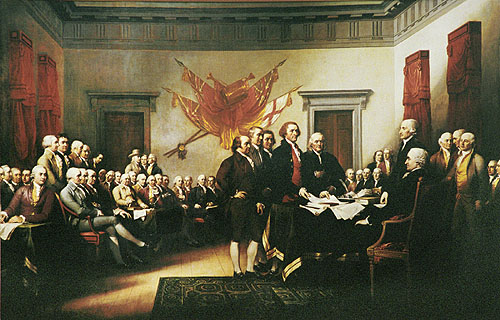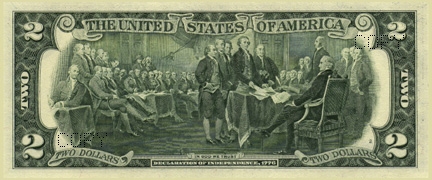Signing of the Declaration of Independence...
July 4th, 1776
 IN CONGRESS, JULY 4, 1776
The unanimous Declaration of the thirteen united States of America
The first painting that Trumbull completed for the Rotunda shows the
presentation of the Declaration of Independence in what is now called
Independence Hall, Philadelphia.
The painting features the committee that drafted the Declaration of
Independence — John Adams, Roger Sherman, Thomas Jefferson (presenting
the document), and Benjamin Franklin — standing before John Hancock,
the President of the Continental Congress. The painting includes
portraits of 42 of the 56 signers and 5 other patriots. The artist
sketched the individuals and the room from life. ~~~  | hen
in the Course of human events it becomes necessary for one people to
dissolve the political bands which have connected them with another and
to assume among the powers of the earth, the separate and equal station
to which the Laws of Nature and of Nature's God entitle them, a decent
respect to the opinions of mankind requires that they should declare
the causes which impel them to the separation. |
 | The
Declaration is considered to be a preceding founding document of the
later formed United States of America, where July 4 is celebrated as
Independence Day.
At the time the Declaration was issued, the American colonies were
"united" in declaring their independence from Great Britain, but were
not yet declaring themselves to be a single nation. That union would
evolve and take shape during the next few years after the Declaration
was issued. |
 | Thomas Jefferson -- author of the Declaration of Independence and the
Statute of Virginia for Religious Freedom, third president of the
United States, and founder of the University of Virginia -- voiced the
aspirations of a new America as no other individual of his era. As
public official, historian, philosopher, and plantation owner, he
served his country for over five decades.
Born April 13, 1743, at Shadwell, Virginia;
died July 4, 1826, Monticello
|
 | President Abraham Lincoln explained the importance of the Declaration to American history in his Gettysburg Address of 1863:
"Four score and seven years ago our fathers brought forth on this
continent, a new nation, conceived in liberty, and dedicated to the
proposition that all men are created equal." |

|